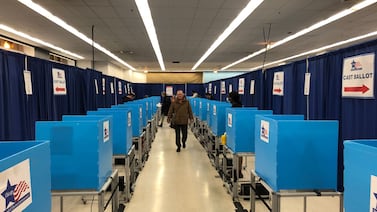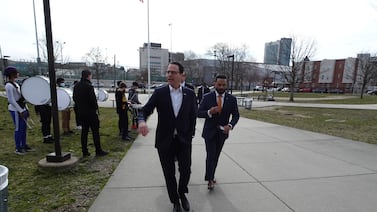Sign up for Chalkbeat’s free weekly newsletter to keep up with how education is changing across the U.S.
Dylan Beitz’s ears perked up when federal officials announced last month that a new rule would allow more schools to offer free breakfast and lunch to all students.
That rule would cover Jefferson County schools, the district in West Virginia’s Eastern Panhandle where Beitz oversees child nutrition. Before the change, the district fell just below the federal cutoff for offering free meals to all 8,400 of its students as part of a national program meant to help high-poverty schools.
Under the new rule, which takes effect later this month, Jefferson County could go from offering free meals in seven schools to all 16. Beitz knew that could save the district time and labor — no more mailing bills for unpaid meal debt — and give families extra money to spend on other expenses.
“I think it’s something that we want to go to,” Beitz said. But first, the district has to see if it can afford to “bite that bullet” if there are out-of-pocket costs: “We’ve really got to look and see what the financial repercussions are.”
Beitz isn’t the only one crunching the numbers. Recent headlines proclaimed the new rule would grant millions of students access to free school meals. And there’s research indicating that universal free meals may provide academic and other advantages for students. Yet federal officials and school nutrition experts say many kids who could benefit will actually miss out.
That’s because without additional funding from Congress that’s probably not on the horizon, districts that want to participate must weigh the costs and benefits of providing more free meals against other priorities.
“Unless they have additional resources, or the state is able to provide additional resources, a lot of the newly eligible schools will find it difficult financially to implement that,” said Crystal FitzSimons, who oversees school nutrition work for the nonprofit Food Research & Action Center, which advocated for the new cutoff.
A spokesperson for the U.S. Department of Agriculture, which oversees school meal programs, said it’s up to districts to opt in and the agency knows not all newly eligible districts will do so.
The change affects a federal program known as the community eligibility provision that allows schools to provide free meals to all students regardless of family income. It has shot up in popularity in recent years, as schools got used to providing free meals to all kids under a temporary pandemic-era policy, and didn’t want to go back to charging them when that expired.
Under a previous rule for that program, individual schools or entire districts could offer free meals to all kids if at least 40% of students met certain criteria that showed they were from low-income backgrounds. The new rule lowers that to 25% of students. Around 3,000 school districts serving some 5 million students are newly eligible, federal officials said. That represents around 10% of all public school students in the U.S.
Agriculture Secretary Tom Vilsack touted the change as an important step toward fulfilling the Biden administration’s pledge that it would expand access to free school meals to millions more children in the coming years.
In feedback collected by federal officials, some school staff said the lower threshold would help their districts that didn’t qualify under the old cutoff, “but they know students in their communities experience widespread food insecurity.”
Still, many districts that are newly eligible may choose not to participate because they’d rather spend money on things like classroom activities or staff salaries.
Before the rule change, schools and districts that were just above the old 40% threshold often didn’t participate because it was hard to break even under the formula the federal government uses to reimburse schools for the free meals they serve.
Last school year, two-thirds of schools that served 40% to 50% of students who met the low-income criteria used the community eligibility provision, a 50-state survey conducted by FitzSimons’ organization found. The take-up rate rose as more students were identified as being from low-income families.
That financial calculus is unlikely to change anytime soon. In its most recent budget, the Biden administration proposed raising the federal reimbursement for school meals in a way that would help districts that serve lower shares of students from low-income families provide free meals to all. But Congress would have to agree — and Republican leaders have previously opposed additional spending to make meals free for kids who don’t already qualify.
To decide if the free-meals-for-all route makes financial sense, newly eligible districts should look at whether they’d save money by reducing administrative work, and if there would be “any financial improvements because of economies of scale and increases in breakfast and lunch participation,” FitzSimons said.
Eliminating meal debt, and the need to collect it, could also be a reason to opt in, she said.
School officials want more aid from federal government
The community eligibility provision is different from the temporary universal free school meal programs that all schools were permitted to run during the pandemic, and the permanent state-run programs that eight states adopted after Congress failed to pass a national universal meals program.
Those programs generally offer free meals to all public school students in the state regardless of income, and require additional state spending.
Federal officials and school nutrition experts expect many districts in those eight states will take advantage of the rule change because it will cut down on paperwork and allow for more federal funding. More districts in states that help pay for the cost of participating in the federal program, such as New York and Oregon, may opt in, too.
Districts that want to make this change mid-year will have to work with state education officials to seek a waiver from the federal government. Some, like New York, have already opened an application process.
Kate Dorr, who oversees food services for 16 districts in central New York, is planning to apply to bring on the last three schools in her area that do not yet serve free meals to all students.
She knows it will help many families. Last year, meal debt in her districts spiked from zero to $150,000. Dorr had many painful conversations with families who struggled to afford food, but no longer qualified for free meals.
But without the New York state subsidy, providing free meals to all students would be hard to afford, she said. That’s why she wants federal officials and lawmakers to do more to support school nutrition programs like hers.
“I really feel for states that don’t have this kind of supplemental funding,” Dorr said. “This change from 40% to 25% just feels like way too little, when so much more is needed.”
Kalyn Belsha is a senior national education reporter based in Chicago. Contact her at kbelsha@chalkbeat.org.







